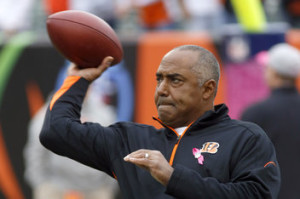On Monday, I examined the seasons of the teams in the AFC and NFC East. Today I will do the same for the AFC and NFC North, starting in the AFC.

Pittsburgh Steelers
Pre-season Projection: 10 wins
Maximum wins: 11 wins (after weeks 2, 5, and 9)
Minimum wins: 8 (after week 16)
Week 1 comment: Sunday Night was one of the best games I’ve seen from Ben Roethlisberger. An elite team that will be favored to win most weeks, although questions remain about the offensive line, the running backs, and the age of the defense.
Pittsburgh started off 6-3 and looked like a contender, but tanked in the second half of the season once Roethlisberger went down. Even when Roethlisberger returned, the offense never quite looked right. Jonathan Dwyer, Isaac Redman, and Rashard Mendenhall were unexciting plodders, which is an improvement over the 25 carries that went to Baron Batch. No Steeler finished the season with more than two rushing touchdowns. In the passing game, Mike Wallace and Antonio Brown both failed to match last year’s lofty numbers. The potential was there, but the results were not in Pittsburgh in 2012.
On the other side of the ball, Pittsburgh’s defense performed well by conventional measures — through week 16 (which is when they were knocked out of the playoff race), they ranked 1st in yards allowed and first downs allowed, and ranked 2nd in net yards per attempt allowed, rushing yards and rushing yards per carry allowed. But the defense wasn’t really up to Steelers standards — through week 16, they ranked 10th in points allowed and, more damningly, had forced more turnovers than just three teams. Pittsburgh allowed 5 4th quarter game-winning drives, which ultimately cost them the playoffs.
Baltimore Ravens
Pre-season Projection: 10 wins
Maximum wins: 11 wins (first after week 3, last after week 13)
Minimum wins: 9 wins (after week 15)
Week 1 comment: Great performance on Monday Night, but I have to imagine missing Terrell Suggs is going to hurt this team. He’s too good to simply expect business as usual in Baltimore, and their schedule (AFC West, NFC East, Houston, New England outside the division) is riddled with traps.
The schedule was riddled with traps, but the Ravens rode some late-game success and excellent special teams to a 9-2 record. At that point, I wrote: I still don’t believe in this team, because they aren’t going to have amazing special teams or amazing 4th and 29 conversions every week.
Joe Flacco had a solid but not great year, while Ray Rice continued to prove effective when given the carries. The big issue for Baltimore was defensively. Through 16 weeks, the Ravens ranked 20th in yards allowed, 18th in NY/A, and 24th in first downs allowed. While the Ravens won the North, 8 games out of Terrell Suggs, 6 games of Ray Lewis, and 6 games of Lardarius Webb simply wasn’t enough to give them the defense Ravens fans were used to seeing.
[continue reading…]




